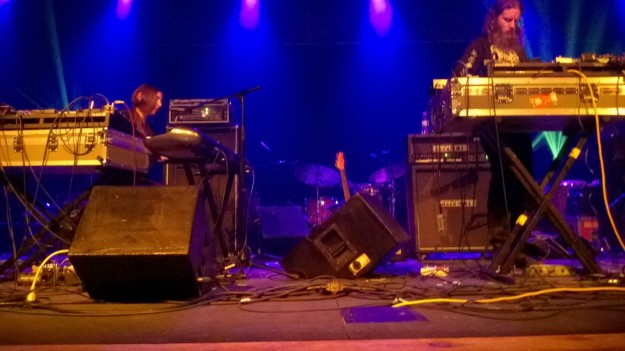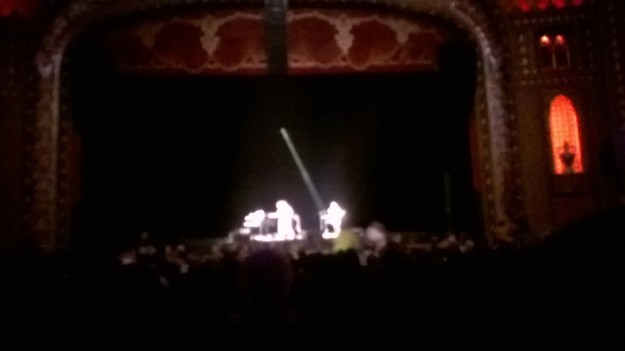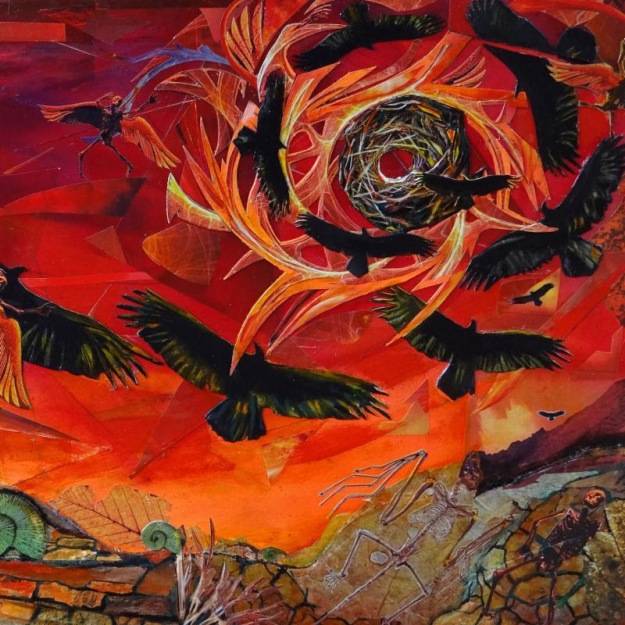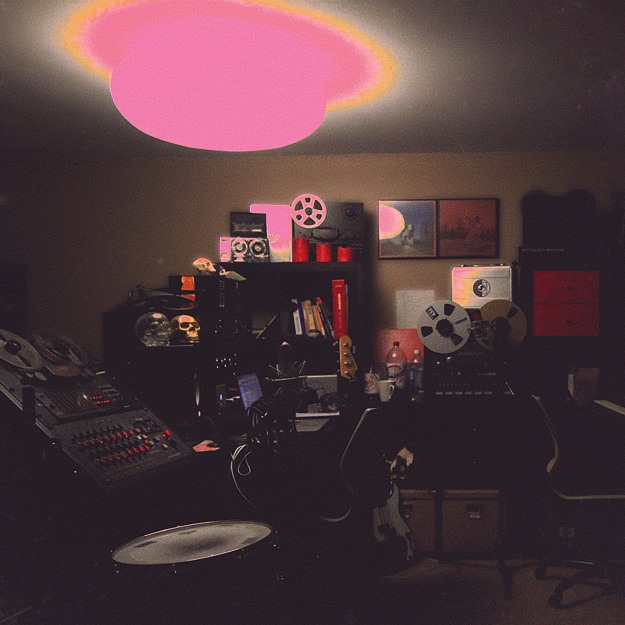The Big Ears music festival in Knoxville, TN stands as one of the southeast’s best kept secrets, although for how much longer that secret will be kept I can’t say. This was after all, my first year with any knowledge about the festival whatsoever and it managed to sell it’s highest number of tickets yet. I’m not normally a huge festival goer, but when I saw this lineup, or at least the artists that I actually recognized on the lineup, I made a commitment to go even if my friends who were interested weren’t able to make it or flaked out for whatever reason. Lo and behold, that actually happened, so March 31st I found myself ascending ol’ rocky top on I-40 to get a three day taste of paradise on my own.
Thursday
The ease and accessibility of Big Ears cannot be praised enough. I’ll admit to some initial stress as I searched for parking and began trying to familiarize myself with downtown and the routes to and from the different venues I needed to know, but it didn’t take long for me to figure out that not only is downtown Knoxville quite easy to navigate, everything related to the festival was within reasonable walking distance. It turned out once I knew where I was going that even the parking couldn’t have been less of a headache; on Friday and Saturday night I parked right outside of Mill and Mine for free which was always the last venue that I was to leave from. On Thursday I allotted myself plenty of time to find my way around so I headed to the Sanctuary to check out John Luther Adams’ Veil and Vesper sound installation well before any of the slated performances started. Veil and Vesper consisted of speakers arranged in the church sanctuary in such a way that the blankets of ambient sound emanating from them could take on a different mix or context depending on where the listener was standing. While I roamed the sanctuary for quite a while I noticed that most listeners were sitting stationary, eyes closed as if in deep meditation as the sounds shifted and morphed at a glacial pace. The unfolding of each chord was so spread out that one listener was overhead saying “That guy makes minimalism look like heavy metal” outside. While I enjoyed the installation, I think that a need to check out as much as possible kept me from sticking with it long enough for it to truly reach a spiritual level of resonance inside me.

The brand spankin’ new Mill and Mine is one of the nicest and largest venues I’ve ever been in and so just happened to be hosting Mammiffer as it’s first ever performance thanks to Big Ears. I checked my schedule again and again to make sure that I wasn’t wrong seeing how 10 minutes before the first band was slated to play I was almost the only person in the room. Another Big Ears pro; if you show up early you’ll rarely have to fight a crowd. In addition to their Mare Decendrii LP being on my turnable quite a bit these days, Mammiffer was an easy choice just based on the personnel alone. The band usually consists of a husband wife duo of the greatly talented Faith Coloccia, and the former singer/guitarist of one of my favorite bands of all time, Aaron Turner. In case you don’t know, the band I’m talking about is Isis and he’s also done great work in Sumac and just about everything else he’s had a hand in. This was an especially special performance given that the two of them were joined by Brian Cook: also of Sumac but also of Russian Circles and formerly of These Arms are Snakes and freaking hardcore legends Botch. If you’re familiar with this site you may know this already since his tone trailblazing is a constant source of inspiration to me, and should be to other (slightly) discerning bassists. This was a far cry from your typical heavy music set though, Mamiffer slowly and deliberately culled a sea of delay drenched noise that almost tempested out of control just before some melody started to break through. Once it did it was all goosebumps, the golden moment being when Faith’s angelic voice started sifting through the doom-y chords that Aaron and Brian were pacing the song with. This set seriously almost brought a tear to my eye, and these avant-doom narratives are meant to be beheld live.

Big Ears is likely the only place where I can follow a set by some of my post-metal heroes from years gone past with a set by free-jazz giants the mighty Sun Ra Arkestra. Longtime Ra collaborator Marshall Allen was conducting/leading when not pushing his tenor saxophone to it’s limits, and a good age range throughout the group kept a good balance between experienced and young/hungry that truly kept the spirit of Ra alive. This was a jazz set to end them all, while some could certainly call some of the melodies and rhythms hard-bop and maybe even funky in places, the band still knew how to crash into each other in the kind caucophonic runs that I expected from the unpredictable group. In true Sun Ra Arkestra fashion, wind and brass players would venture out into the crowd, play amongst us, and still somehow managed to stay in time with the rest of the group. Controlled chaos would be a great way to describe it; whenever things became unhinged it was always completely necessary and thrilling. Having crossed a big name off my list of groups that I needed to see before I’m dead, I thought I may still catch some Wolf Eyes down the street at the Standard.

…And I was wrong, they were just finishing right as I got there so I retreated back to Mill and Mine for Yo La Tengo. What followed was a very Big Ears moment: Yo La Tengo took the stage with a myriad of guests including Bryce Dessner and one of the Arkestra’s wind players and proceeded to do an entirely improvised set of structureless, dense sonics. While I heard from many fans the next day that this was a bit of a disappointment for those who wanted to hear actual Yo La Tengo songs, I rather enjoyed it not exactly being a long time listener of their usual catalogue. I also daresay that this was a one-time only thing that I can say I was there for. Reactions were mixed but still positive, with some content to lay down on the hardwood floor and let the ever-shifting sounds wash over them. That’s one of the cool things about this festival, this is the sort of thing that people come here for.
Friday
The next two days were more full than Thursday and my particular Friday started off with the Lou Reed’s Drones installation as presented by Laurie Anderson. Like Veil and Vesper I’d say that this needed to be experienced in person for one to fully appreciate it. A semi-circle of amplifiers stood in a corner of the room, each with a guitar leaning against it front facing inward. Someone (Lou Reed’s guitar tech from what I was told) was there to manipulate knobs on the amps and the sound textures morphed accordingly. The results were sometimes pretty surprising, and to add to the atmosphere the lights were turned low with blankets, pillows, and chairs strewn about the space for people to turn off and zone out. I myself spent a good bit of time meditating amidst the sound before I walked to Mill and Mine for Zeena Parkins and Tony Buck. I was vaguely familiar with these two artists, but maybe only enough so to know have a faint idea of what Parkins’ harp playing in Phantom Orchard is like and that Tony Buck usually plays for experimental/dub/jazz giants The Necks. What followed was an enlightening set of improvised sound that took many different directions and had an air of catharsis about it. While I knew that Parkins could get alot of unusual sound out of her harp and effects, some of the more percussive nature, it was actually Buck’s using of his drumkit and hand percussion in such textural and ambient ways that really surprised me.
I checked out Chris Abrams at the Square Room while waiting for Anthony Braxton, while the room itself was great this was by far the smallest and most overcrowded of the Big Ears venues. I wasn’t familiar with the music of Chris Abrams, but when he walked out to his piano and began letting loose an unfolding of rapid, yet slow shifting piano melodies I was blown away . His textures seemed to morph in and endless stream of notes that never seemed to break, the continous piano playing of Lubomyr Melnyk came to my mind
Next up was Anthony Braxton’s 10+1 tet at the Bijou Theater, which was a pretty long walk from where I was. Another mind-blowing but none too accessible performance, in alot of ways I saw what Braxton and his group did as being a larger extension of what I just heard/witnessed at Mill and Mine. Here I heard jazz musicians communicating with each other like I never had before, not so much with notes that fit into particular scales but more of a sonic conversation representing both joy and agony. There was something oddly advanced and primitive co-existing there in that set. The group consisted of horns, winds, and two guitars that plunged in fearlessly after Braxton into free-form atonal improv. I took off quickly towards the end and headed to the Standard, because if my program was promising free barbecue then I was going to be sure to be there for some. The line was long but you can’t argue with free Sweet P’s, and being a stout fiend I had to try some of Goose Island’s limited Bourbon County stout even if it was $8 for a 12 oz. cup. What I was really excited for though, was Boogarins, who were up next downstairs.
Brazilian psych-rock band Boogarins were a late addition to the festival but all it took was a short listen on Youtube for me to come to the conclusion that I needed to be there for their set. Once again I walked directly to the front and waited for the room to slowly fill up. Boogarins did not disappoint, it feels goofy saying that any band “rocked” at Big Ears but if any band did, it was them. It wasn’t just the day of abstract music that made their levitating grooves so welcome either, the band’s mix of tropicalia and psychedelic pop/rock was absolutely electric live, and the band had a tightness and an onstage energy that was well paced and always engaging. The rhythm section was monster as well, I was directly in front of the drummer and he killed the kit so hard that my ears were probably ringing more after this set than they were after any other BE performance I saw. The bassist dug up nice, warm, mud from his Gibson SG bass and a very close to the neck finger pluck technique that fit in with the mix perfectly. Interestingly enough, said bass player was only using three effects (one of which I could see was a Vox Delay-lab) but somehow seemed to posses a pretty varied tonal range…Then I checked out both guitarists’ boards and realized that they were all using relatively small amounts of pedals. It goes to show that there is a certain mastery to psychedelic music that can’t just be found in gear.

After hitting Boogarins’ merch table I took a break at Mill and Mine which had sort of become my home base at this point for it’s water fountains, nice bathrooms, and power outlets. I also knew that Shabazz Palaces would be starting soon and I didn’t want to miss that. There was a noticeable shift in demographic at this point, Heiroglyphic Being had just done a dance music set with Marshall Allen and the only hip-hop artist of the fest was getting ready to take the stage, so the atmosphere got alot younger and dance-friendly quickly. Shabazz Palaces had a bit of a rough start but when the sound guys finally got the bass and vocals up to a point where things (and hips) shook the way they should their set really lit up. Both members stayed busy with samples and beats and the rhymes were delivered spot-on, this was a show to prove that modern rap doesn’t have to come without provoking thought. This is where my night got a bit conflicted and split-up, I wanted to check out Ikue Mori which would make me leave the show I was at early, and then leave Ikue Mori early if I wanted to see Eighth Blackbird at the sanctuary. I decided to stick to that plan and got to the Square Room once Ikue Mori had already started her set.

Once again the Square Room was packed but this time there was no performer on stage, rather a large screen projecting the accompanying films that were to be set to Ikue Mori’s music. As I settled in the back I noticed that I was actually sitting right next to Ikue at the soundboard where she was conjuring up the other-worldly sounds that constitute her mesmerizing music. As for the visual aspect, there’s really nothing I can say to describe how surreal it was. I’m sure this is due in part to the fact that I’m not well educated in how different forms of film and photography work, but it was the perfect combination, narrative and all, to go along with Ikue’s music and make a truly out of this world experience. The collection of films had occasional text narrative and seemed to use puppets or dolls as many of their subjects. This made for one of the truly pleasant surprises of the festival. While I wanted to stay to the very end, I got a feeling that I should head to the sanctuary.
It turns out I should have done so even earlier if I wanted to see Eighth Blackbird, as there was already a huge line wrapping around the building. Ushers came out to let the crowd know that they were reaching capacity at a point in the line that was still very far away from me so things weren’t looking good. I could either stand there and just hope that enough people would leave for me to have a chance, or I could go to Bombino at Mill and Mine. I went with the sure thing, and while I can’t attest to how awesome Eighth Blackbird might have been I wasn’t disappointed with Bombino. Bombino brings and interesting story and a cultured take on guitar-based music with him, his style combining elements of eastern, more specifically, Tuareg music with western, blues-based rock. His songs had a repetitive, hypnotic quality that often times grooved consistently but on occasion would gradually speed up until the end of the song, during which he’d bring the crowds movements with him with every beat. He played with three other musicians: a rhythm guitarist, bassist, and drummer, making what was probably one of the most straight-forward and familiar setups of the entire weekend. If looked like the bassist was manning a five-string Spector, and his finger-picked rumbling seeped down into sub territory where it was sometimes felt more than it was heard. That’s with the exception of the moments where his smooth playing took on a more plucky, almost woody and percussive sound which felt right with the mix of eastern and western influence. I was barely hanging in there at this point so I enjoyed my last set of Friday then took my leave to get some rest.
Saturday
Saturday was the day that I was looking forward to the most although in retrospect I probably should have gotten my day started earlier to take in more. The first act of the day that I saw was Maya Beiser at the Bijou Theater and this was already afternoon. Maya’s performance was nothing short of breath-taking and after witnessing it anyone would be hard pressed to find a better cello player on the planet. My favorite portion of her set was her stupefying performance of Steve Reich’s “Cello Counterpoint”, in which she played along to seven video and audio recordings of herself playing different parts of the piece and somehow braving the rhythmic madness and beauty of it. It turns out the ghost of Lou Reed wasn’t just at the Drones installation, but also present when Maya performed a haunting vocal and cello rendition of The Velvet Underground’s “Heroine”.
I went down the street to the gorgeous Tennessee Theater for one of the most anticipated performances of the weekend, Laurie Anderson and Philip Glass. The Tennessee Theater could be the nicest venue I’ve ever been in, and was a perfect backdrop for such an epic event and beautiful a performance. Glass manned his piano across the stage from Anderson and her violin to rapturous applause and the two of them were all that was needed for some truly soul-stirring renditions of each other’s music. Anderson’s spoken word to the pieces had a spell-binding effect and there was certainly something purely otherworldly about the whole experience. Spoken word was also provided by a recording of Allen Ginsberg’s “Wichita Vortex Sutra” with which Glass played his accompanying piece of reflective piano music. I couldn’t help but wonder to myself, was Ginsberg narrating the music or vise versa? The performance was concluded with it’s greatest moment; a new rendition of the first piece from Philip Glass’ seminal Glassworks album, which aside from being one of my favorite Glass pieces was simply breathtaking. It was going to be hard to top this but I knew the day still had plenty of great music ahead.

Even though the Bijou was right down the street and the Necks weren’t scheduled to play for another 30 minutes, I was surprised to find that the venue was already at capacity. Because of this I decided on an early dinner at Stock and Barrel (recommended) and then walked back to the Bijou for Nico Muhly, Sam Amidon, and Nadia Sirota, none of which I was familiar with in the least before this show. The praise I was hearing from fans all around me when I sat down promised me I was in for something special and they weren’t wrong. Muhly and Sirota’s piano and violin pieces were dizziyingly complex, yet still captivating, to the point that sometimes I simply couldn’t wrap my head around the seemingly formless barrage of notes and un-tethered melodies. As if to provide the perfect counterbalance, Sam Amidon’s songs had his bare voice and acoustic guitar bringing serenity over the theater in the folkiest songs I heard all weekend. These three musicians continued to blow my mind and the reception they received after their last song was the most spirited that I witnessed at Big Ears. It was good enough that I observed the guy next to me shaking his head and cursing under his breathe before breaking into applause after each song, like he knew he was witnessing music being performed on some new level.

Back at the Tennessee Theater, I was very excited for Sunno))))) and put my certainly soon to be gone eardrums to use by enjoying two songs of doomy grunge from Big/Brave. With the curtain still drawn, all it took was a single muted chord for some of the ushers to head for cover, which brought to light the true absurd awesomeness of getting to see the world’s heaviest doom band in such a lovely and historic venue. Although it probably isn’t too difficult to imagine that the ritualism of Sunno))))’s set seemed right at home here, while smoke poured out around the stonehenge of amplifiers and the hooded members took the stage, I couldn’t imagine a more perfect setting. Attila’s crawling, guttural vocal incantations certainly didn’t dispel the ritualistic feel either. I suppose there is not really much that can be conveyed in words about what it’s like to experience them live, but imagine low, distorted frequencies so powerful that they vibrate everything inside and around you. I have to say though, given the size of the venue I think everything had enough room to project and travel without the voluming becoming overbearing. Sure it was loud, but it was never painful, it was more like the sonic equivalent of easing yourself into a hot-tub. I was also glad to hear some unconventional drone in the form of cacauphonic trombone playing rather than just pure electric exultation.

All good things must come to an end, and if you’re going to end something try to do it with Kamasi Washington. I had a difficult time deciding between Kamasi, Faust, and Kiasmos for my last headliner, but let it speak for the quality of his new album The Epic that I went with Washington over the krautrock legends and beautiful ambient dance music duo. Once again I was surprised at how close to the stage I got at Mill and Mine and only had to deal with one annoying drunk guy behind me amidst the otherwise pleasant and respectful people. Kamasi’s group consisted of himself, a trombone player, a vocalist, keyboard, upright bassist, two drummers, and some occasional flute courtesy of his father. This ended up being the right sized group to give good interpretations of songs off The Epic; not as brimming as the recording but not too small. The group seemed to almost be easing their way in to “The Changing of the Guard”, but once they were there they were on fire. By the time they started “Leroy and Lanisha” they were carrying on a musical conversation in which they seemed to be having the time of their lives. An emotional performance of “Henrietta, Our Hero” was a highlight, and they even played some new music from some of Kamasi’s cohorts’ upcoming records. Of course the musicianship was unbelievable, both drummers seemed to have been competing for a world’s best drummer title and Myles Porter did things on the stand up bass that I had never conceived. Hopefully other bassists will note his use of effects and their potential outside of the electric bass realm. It was a joyous show but by the end I was exhausted, although in all fairness that can probably be credited to the entire weekend finally catching up with me.

As much as I would have loved to stay for Sunday’s outdoor performance of John Luther Adams’ “Inuksuit”, I had made my weekend plans long before they announced that there would even be a Sunday performance, so late Sunday morning I said a reluctant goodbye to Knoxville. I’m still a bit overwhelmed by what I experienced there. I never would thought that there could be such an open and un-pretentious audience for experimental music, not only in the US, but right here in the southeast. I learned that a music festival can, and should be more than drunk, selfie-taking tourists herded out into the hot sun. I learned that even in this day and age where our access to information is seemingly unlimited, it is still possible to be surprised and inspired. See you again next year.















